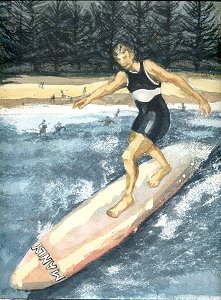pods
for primates : a catalogue of surfboards in australia since 1900
 |
surfresearch.com.au
exhibition
2009
|
(About)
100 YEARS OF AUSTRALIAN SURFBOARD RIDING, 1909 - 2009.
Surfboard
Exhibition
-
100 Boards - 100 Images - 100 Stories -
Gerringong
Town Hall, South Coast, NSW
-
One Day Only -
SUNDAY
13th DECEMBER 2009.
9.00
am - 4.30 pm
"A
splendid time is guaranteed for all."
Contact: Geoff
Cater (02) 44487490
geoff@surfresearch.com.au
-
ADMISSION: $0 (FREE, NOTHING, ZERO) -
|
|
Research
Paper :- surfboard
shooting in australia 1900-1940
Many
thanks to ...
John McInnes and
Kiama Council, Shoalhaven City Library,
Jeff Fox, Paul Flack,
Mick Morgan (ACS), Scott Andrews,
Darrell, Bob Simmons, Duke Kahanamoku.
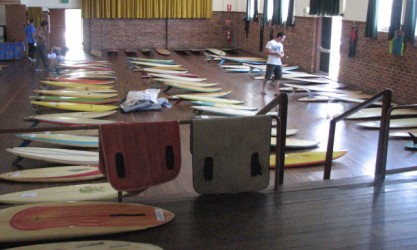
Main Hall : Single Fins 1958 to
1982.
Gerringong Town Hall Surfboard Exhibition,
December 2010.
Not shown:
Twin Fins 1975 to 1982, Thrusters
1981 to 1990, Sailboards,
Framed Images, The House of Wax,
Fin-tasia, Boardshorts, Shirts and Wetsuits.
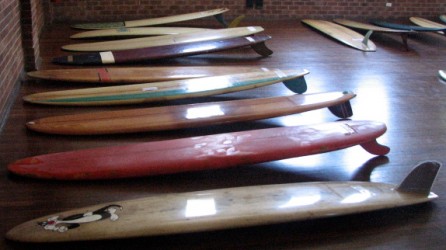 Malibu Boards 1958 to 1966.
Malibu Boards 1958 to 1966.
|
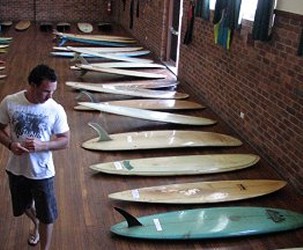 Transition Boards 1966 to 1969.
Transition Boards 1966 to 1969.
|
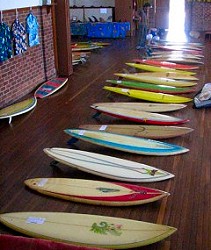
Single Fins 1973 to 1982.
|
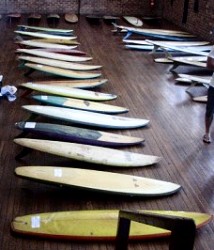
Single Fins 1970 to 1973.
|
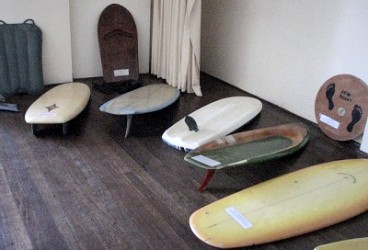 |
Prone & Knee Boards 1. |
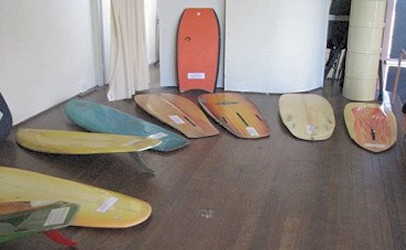 |
Prone & Knee Boards 2. |
Exhibition
: FIFTY YEARS of the MALIBU SURFBOARD
in AUSTRALIA. 1956 - 2006.
Shoalhaven
Heads Surf Life Saving Club. Sunday 17th September 2006.
Catalogue - in Preparation : 1. Surfboards
1956 Okinuee
Manufacturer
uknown. Approximately 9ft 6''.
Plywood on timber
frame, timber fin.
A Malibu design,
built with the existing hollow wood technology before Australian manufacturers
were able to source supplies of balsawood.
This example was
originally varnished but currently with a painted finish and is the club's
Honour Board.
An early example
of this is Geoff. Cohen's board, the first Manly S.L.S.C. member killed
in World War II, which became the club's War Honour Roll.
Item courtesy
of Shoalhaven Heads Surf Life Saving Club.
1957 Balsa Malibu
Manufacturer unknown.
8 feet 8 1/2''
Balsawood &
fibreglass with D fin.
Similar to the boards
brought to Australia by US and Hawaiian life savers to the International
Surf Carnival at Torquay in conjunction with the 1956 Melbourne Olympics.
Extensively restored,
the painted graphics are typical of the period.
Item courtesy
of James Merrick Cater. (JMC)
1959 Pig Board
Scott Dillon Surfboards,
Brookvale. 9ft 1''.
Foam and fibreglass
with fibreglass fin.
The board has expanded
above the stringer - an indication of early difficulties with foam production.
The full colour
decor disguised blank and glassing defects.
Original metal adhesive
decal and fin, which is a radical design for this period.
Scott Dillon started surf-rding at Bondi around 1950 on a solid timber
board.
A noted big wave rider, he was a major Brookvale manufacturer,
circa 1959 to 1972.
1962
Malibu
Manufacturer unknown.
9 feet 8 1/2''
Balsawood &
fibreglass with redwood stringer and laminated timber fin and tailblock.
The surfcraft permit
sticker is a reproduction.
Possibly made by
Wally Caryle, Rockdale. Possibly hollow.
1965 Noserider
Gordon and Smith
Surfboards, Caringbah. 9ft 7''
Foam and fibreglass
with full colour pigment decor, dorsal fin and rare laminated foam tailblock.
The Australian company
was started by Floyd Smith of Gordon and Smith Surfboards USA, circa 1965.
The nose patch and
band decor is derived from the noseriding 'craze' epitomised by Tom Morey's
(designer of the Morey Boogie Board, see P1975) where the competitor was
timed when riding on the designated nose section.
Item courtesy
of Paul Flack.
1965 Stringerless
Hohessee Surfboards,
Queensland. 9ft.
Foam, clear with
Volan rail lap, Pop Art decals, cloth nose patch and high aspect fin.
The stringerless
design was introduced by Midget Farrelly and the hign aspect fin by George
Greenough in early 1965.
1966 Thin Rail ('Sam')
Keyo Surfboards,
Brookvale. 9ft 4''.
Foam with redwood
stringer, clear with Volan rail lap and laminated high aspect fin.
Typical Australian
thin-rail design with a noticeable reduction in thickness and ridden by
Nat Young in his emphatic victory in the 1966 World Chamionships.
The Keyo decal was based on the classic
Hobie Surfboards (USA) decal.
1967 Vee Bottom Stubby
Shane Surfboards,
Brookvale. 8ft.
Stringerless foam
blank, Volan rail lap, double diamond deck patch and chamfered pod.
An extreme design with a wide tail, deep
vee bottom and high aspect flex fin.
Critically the design was to undergo radical
decline in length from about 8ft 8'' to 7ft by early 1968.
Commonly refered to as the beginning of
the Short Board Revolution.
1967
Vee Bottom Stubby
Wallace Surfboards,
Brookvale. 7ft 8''.
Stringerless foam
blank, Volan rail lap, Pop-art decal and chamfered pod.
An extreme design with a wide tail, deep
vee bottom and high aspect flex fin.
Critically the design was to undergo a
radical 20% reduction in length from about 9ft to 7ft by early 1968.
Commonly refered to as the beginning of
the Short Board Revolution.
Item courtesy
of Paul Flack.
1968 Pintail Vee-Bottom.
WM Surfboards, Auburn. 7ft 11''.
Following the failure of the Vee-bottom
design in the Hawaii in December 1967, Australian designers initially gave
their deep-vee bottoms a full pintail.
Further development led to the adoption
of gun-type templates, resulting in a further reduction in volume.
This board has unfortunate decor work,
and is severely warped.
1968
Pintail
('Little Red')
George Rice Surfboards,
Victoria. 7ft 10''.
Stringerless foam
blank, Volan rail lap, heart deck patch and Waveset finbox.
The Waveset by Morey-Pope (USA) was the
first finbox commercially accessable to manufacturers.
Available with a range of molded fin designs,
the most popular were by George Greenough.
1968 Tracker
Gordon Woods Surfboards, Brookvale. 8ft.
Stringerless foam
blank, Volan rail lap, pinlines and multi-colour deck patch.
Ususally credited
to Bob McTavish this shows a strong Hawaiian gun influence with a square
tail to increase manourveability for Australian conditions.
Item courtesy
of Bob Munroe.
1968 Pintail
Shane Surfboards, Brookvale. 7ft 6''.
Stringerless foam
blank, Volan glassed with reverse scallop deck patch, gel resin and
gel resin/glitter decor,
pinlines,
SAFE set fin box.
Safeset was a finbox system similar to,
but not compatable with, the Waveset design.
1969 Mini Gun
Surf Design (Surfboards),
Queensland. 7ft. Probably shaped by Dick van Straleen.
Foam blank with
triple (3) black Glue-line stringers, volan glassed with foil knee-patch.
Safe-set fin box .
A radical mini-gun
template, probably built for Burleigh Heads.
The glueline stringer returned some strength
to the board and gave the shaper a fixed sight line.
1969 Bullet
Keyo Surfboards,
Brookvale. 7ft. Shaped by Bob McTavish.
Stringerless foam
blank , Volan glass with Vee knee patch.Safeset fin box.
A wide tail version
of the Min-gun, probably for Sydney beachbreaks.
Bob McTavish is a renowned Australian
surfboard designer.
1969 Diamond Tail
Peter Drouyn Surfboards,
Queensland. 6ft 3'' Peter Drouyn, shaper and possibly rider.
Stringerless foam
blank, Volan glassed with 1 1/2 inch rail lap, Waveset fin box, spray markings.
Radical length and
weight for this period but Drouyn was a surfer of exceptional ability,
winning the Makaha Contest in 1970.
1969 Wide Tail
('White Kite')
Farrelly Surfboards,
Brookvale. 6ft 4''
Foam blank with
black glueline stringer, pinlines, red/yellow pigment laminate. No Fin.
A further adaptation
of the Bullet design, this was most closely identified with Ted Spencer's
'White Kite' model for Shane Surfboards.
The glassing of
the red/yellow pigment laminate to give the orange rails indicates a high
level of craftmanship.
1969 Wide Tail
('White Kite')
Jim Pollard Surfboards,
Newcastle. 6ft 4''
Foam blank with
black glueline stringer, pinlines, green marbled pigment laminate, deck
decor ?.
A further adaptation
of the Bullet design, this was most closely identified with Ted Spencer's
'White Kite' model for Shane Surfboards.
Jim Pollard is credited
with the develpoment of the Channel Bottom design in 1978.
1969 Egg - Super Stubby
Age Surfboards,
Lakemba-Bankstown, 6ft 7".
Foam blank with
black glueline, Tinted Volan glass with tail patch.
A popular Australian
design, notably ridden in this period by Wayne Lynch and Nat Young.
Age Surfboards was
a rare successful 'inland' company, the multi-coloured Bird decal was copied
from Bing Surfboards (USA).
1969 Egg - Super Stubby
Keyo Surfboards,
Brookvale, 5ft 8 1/2". Shaped by Geoff McCoy
Foam blank with
green glueline, tinted Volan glass with tail patch.
A popular Australian
design, notably ridden in this period by Wayne Lynch and Nat Young.
Probably one of
the last boards made by McCoy at Keyo, before he started his own company.
1969 Egg - Super Stubby
Jackson Surfboards,
Caringbah, 5ft 8 1/2". Shaped by Laurie Byrne
Foam blank with
black glue line stringer. Volan glassed with tinted bottom, Vee tail patch
and foil fin patch.
Resin pin
lines.
A popular Australian
design, notably ridden in this period by Wayne Lynch and Nat Young.
Laurie Byrne subsequently
worked for Byrne (no relation) Surfboards, Wollongong NSW, where
he shaped many boards for World Champion, Tom Carroll.
Item courtesy
of Paul Flack.
1969 Slide Slipper (?)
Odin Surfboards,
Ballina, 6 ft 2'' ?. Shaped by Rick Purnell
Foam blank with
dark red glueline, Volan glass, tint, marble deck patch and resin pinlines.
A possible example
of one of the most obscure surfboard designs, it featured a flat bottom,
low rails, hyper-kicked nose and a small fin, often interchangable with
a fin box.
Side slipping, occassionally
extending to an extreme spinning 360, became an recognised manourve in
circa 1969, as demonstrated in John Severson's Pacific Vibrations
(1970).
Designed by Reno
Abellira (Hawaii), in Australia, it was taken up by Midget Farrelly and
Terry Fitzgerald.
1969
Slide Slipper (?)
Keyo Surfboards,
Brookvale, 6 ft 2''. Shaped by Steve Lennard
Foam blank with
dark red glueline, Volan glass, spray/tint/pigment?, fin box.
A possible example
of one of the most obscure surfboard designs, it featured a flat bottom,
low rails, hyper-kicked nose and a small fin, often interchangable with
a fin box.
Side slipping, occassionally
extending to an extreme spinning 360, became an recognised manourve in
circa 1969, as demonstrated in John Severson's Pacific Vibrations
(1970).
Designed by Reno
Abellira (Hawaii), in Australia, it was taken up by Midget Farrelly and
Terry Fitzgerald.
This board features
an Australian version of the Guidance Fin System with a segmented base
that slots into a molded box, and clicks back to lock and secured with
a plastic tab.
1970 Twin fin.
Walsh Surfboards,
Elanora, 5 ft 4". Shaped by Jim Walsh.
Foam blank with
blue glueline stringer, Volan glassed with scalloped 2/3 deck patch,
scalloped nose patch,
fin patches.
This US design (Corky
Carroll, Mike Eaton , Rolf Aurness and David Nuuhiwa) was directly imported
by Tom
Hoyle to Bennett
Surfboards, Brookvale in late 1970.
Concurrently,
Terry Fitzgerald and Greg Hodges "built two five-sixes" from design details
culled from
negotiations
between Shane Surfboards and Corky Carroll, post the Johanna World Contest,
1970.
The design
quickly dominated 50% of the Sydney market, notably from McCoy Surfboards.
1970 Pin tail.
Farrelly Surfboards
Brookvale, 6 ft 6".
Foam blank with
1/8 inch plywood stringer, clear volan laminate with deck and tail patches.
Strong Hawaiian
gun influence with down rails and S deck.
1971 Diamond tail.
Farrelly Surfboards,
Brookvale, 6 ft 3 1/2''.
Foam blank with
1/8 inch plywood stringer, clear volan laminate.
Common Sydney beach
break template, now with down rails.
Item donated
by Nick De Jong.
1971 Diamond tail
Hutchinson Surfboards,
Brookvale ,6 ft 7".
Foam blank, 1/8''
redwood stringer, volan glassed, tint laminate, deck and tail patches.
1971 Tri fin
Plastic Fantastic
Surfboards (USA), 6 ft. Shaped by Danny Calohan.
Foam blank, 1/4"
redwood stringer, Volan glassed with tint, spray deck.
An early three fin
model with small side fins either side of the centre fin, the design was
shaped at Bennett Surfboards, Brookvale, by Bob McTavish.
Experimentation
indicated that the design was more manourvable if the side fins were placed
forward of the centre fin.
A major influence
on the Bonzer design, see 1974.
1971 Pop-Out
Farrelly Surfboards,
Brookvale. 5ft 5''
Foam blank, with
false glue-line stringer , Volan glassed (lap cuts) with bottom
pigment laminate
Popouts first appeared in around1970 and were usually a 5ft 6" X 20"
Egg.
They commonly used stringerless glassed blanks with minimal shaping
to reduce prices by about 40%.
Like most mass-produced craft, most references in surf literature are
usually derogatory.
They were also manufactured by Shane, Wallace and Merrin Surfboards
(Queensland).
1971
Diamond Tail, adapted Tri fin.
McGrigor Surfboards,
Brookvale, 6 ft 5''.
Foam blank, 1/4"
redwood stringer, Volan glassed with tint.
An later three fin
model with post-production small side fins forward of the centre fin, to
increase manourvability.
A major influence
on the Bonzer design, see 1974.
1972 Pintail
Bluebird Surfboards,
Byron Bay, 7ft. Shaped by Bob McTavish
Foam blank, 1/16"
redwood stringer, tint laminate, spray/paint.
North coast mini-gun.
Item located by Andy Mark.
1972 Keel Fin Pintail
Mystic Expressions
(Surfboards), Queensland? 7 ft.
Foam blank,
stringer?, two colour pigment Volan laminate.
A design for very
long walled waves, most identified with Victorian manufacturer Pat Morgan
Surfboards and ridden circa 1972 by Wayne Lynch and Nat Young (the
later in Alby Falzon's Crystal Voyager, 1973).
This crude example
is undoubtedly backyard manufacturered and may have been cut from an older
and larger board (''Backyard Butchery'').
1973 Pintail
Barry Taylor Surfboards,
Nowra, 7 ft 2" Shaped by Barry Taylor.
Foam blank, 1/8"
redwood stringer, Volan glass pigment laminate, spray, homemade
legrope plug.
A hard railed pintail
gun, the commonly reproduced Lightning Bolt decor was to become the 1970's
most recognised surfboard logo as ridden by Gerry Lopez of Hawaii.
The homemade legroe
plug is an upturned chair leg stopper, as recommended in Tracks magazine.
Barry Taylor manufactured
surfboards in Nowra from about 1972 to 1990.
1974 Bonzer
Cooper Surfboards,
Coffs Harbour, 6ft 11''
Fibreglassed foam
blank, 1/8" cedar stringer, spray, molded fin with legrope bridge.
The Bonzer was originally
designed by Duncan and Malcom Campbell (USA), 1971 - 1973
Characterized by
forward concave leading to double concave each side of the centre
fin with two keel- type fins set on the rails (radically toed-in and cambered),
the design appears to be based on Rogallo hang gliders.
Notable Australian
riders included Wollongong's Terry Richardson and Ian Cairns from
Western Australia, who rode a Bonzer to to win the 1973 Smirnoff Contest,
Laniakea, Hawaii.
Californian Bob
Cooper had an indelible influence on Australian surf-riding and surfboards.
He started surfing
at Malibu in 1952, in 1959 he made his first visit to Australia,
followed by an extended stay 1964 - 1966 and permanent residence from 1969.
Initially working
for major manufactuers in Brookvale and Queensland, Cooper started Cooper
Surfboards at Coffs Harbour, circa 1970.
1976 Stinger
Scott Dillon Dillon
Surfboards, Coffs Harbour, 6 ft 8". Shaped by Billy Urbany (USA)
Fibreglassed foam
blank, with 1/4" redwood stringer, tint laminate, resin pinlines.
Designed in 1974
by Ben Apia (Hawaii) and characterized by The Sting
- flyers set 2/3 rds back from the nose and a swallow tail.
Fin boxes were common
and early models featured a stepped bottom at the flyers.
Famously ridden
by Buttons and Larry Berltlemann (Hawaii) and Mark Richards of Australia.
Scott Dillon closed
his Brookvale factory and moved to Coffs Harbour to ''retire'', circa 1972.
This board spent
much of it's life as a hand painted sign for a surf shop.
1976 Round Tail
Barry Bennett Surfboards,
Brookvale, 7 ft. Shaped by John Foster.
1/4 '' Stringer,
foam blank, fibreglassed, spray.
Donated by John McInnes.
1976 Diamond Tail
Gordon and Smith
Surfboards, Caringbah, 7 ft. Shaped by Peter Townend.
Volan (?) Fibreglassed
foam blank, 1/8" redwood stringer, spray.
Handshaped Tube
Shooters model with thick foiled timber fin, by Queenslander, Peter
Townend.
Townend won the
inaugral IPS 1976 World Tour rankings, second was fellow Bronzed Aussie,
Ian Cairns.
Both riders appeared in John Milius' homage
to the early days of Malibu, Big Wednesday (1978).
1976 Rounded Pin
McCoy Surfboards, Avoca Beach, 6 ft 6".
Fibreglassed foam blank, 1/4" redwood
stringer, spray,
Standard flat deck, rounded pintail with
wide based Brewer fin of this period.
Purchased new by Bob Armitage at Nowra,1976
and extensively ridden and repaired.
1976 Double Flyer Swallow Tail
McCoy Surfboards, Avoca Beach, 7 ft 2''.
Designed
by Reno Abelliro (sic) model.
Fibreglassed foam blank, 1/4" redwood
stringer, laminated pigment, pinlines, spray?
The 'Ligtning Bolt' pinlined rail decor
and the dappled Brewer fin were features of this model.
Made under license in Australia, McCoy
also produced models from fellow Hawaiian, Barry Kanaiaupuni.
Strangely, Reno's surname is spelt incorrectly...
Abellira not Abelliro.
1976 Pintail
San Juan Surfboards, Byron Bay, 6 ft 8".
Shaped by John Blanch.
Foam blank, 1/8'' redwood stringer, Volan
fibreglass with tint.
A beautiful example of a Noth coast pintail
of the period.
1978 Pintail
Nat Young Surf Design, Mona Vale, 6 ft
5".
Fibreglassed foam blank, 1/4" redwood
stringer, spray, 8" fin box.
Heavily influenced by Joey Cabell (Hawaii)
this design featured a compressed pintailgun template, concave bottom,
soft box rails with a hard edge, large nose lift and a small Greenough
single fin.
First adaptation for Nat Young was
by Harold Iggy at Weber Surfboards (USA) in late 1969.
Nat shaped the design from 1970 to 1980,
variously at Byron Bay, Bennett Surfboards and Mona Vale.
Donated by John McInnes.
1978 MR Twin Fin
Mark Richards Surfboards, Byron Bay, 5
ft 10" Shaped by Bob Margetts.
Foam blank, 1/8" redwood stringer, spray,
wide base laminated fins.
Familiar with the early 1970's Twin Fin
and influenced by Reno Abellira's Fish board, Mark Richards built
his own version and subsequently refined it with Dick Brewer in Hawaii
1976-1977.
The most popular design of the late 1970's,
promoted somewhat by Richards' extrodinary consistant contest performances.
First manufactured by Morning Star Surfboards,
MonaVale) they were later made by a variety of shapers at Maddog Surfboards,
Byron Bay and Gordon and Smith Surfboards, USA.
Donated by John McInnes.
1978 Double Flyer Pintail
Bronzed Aussies Surfboards, Caringbah,
5ft 10". Shaped by Terry Bishop.
Fibreglassed foam blank, 1/4" redwood
stringer, spray, 9 1/2" fin box. Cheyene Horan Model
Manufactured at Gordon and Smith Surfboards
during Cheyene's short membership of the Bronzed Aussies and not
by his longterm shaper, Geoff McCoy.
1978 Jet Bottom
Kerrawa Surfboards, Avalon, 5 ft 5''.
Shaped by Erle Pedersen.
Fibreglass, foam blank, 1/8 '' Stringer,
spray, finbox.
Extreme bottom channels, the board was
customed ordered by Simon Chipper for stand-up riding.
1979 MR Twin Fin
Byrne Surfboards, Fairy Meadow, 6 ft.
Shaped by Laurie Byrne.
Foam blank, 1/16" redwood stringer, spray.
An example of one of the many copies of
Mark Richards' popular design, see above.
Laurie Byrne shaped many boards for World
Champion, Tom Carroll.
1979 Twin Fin
Pipe Dream Surfboards, Gold Coast, 6 ft.
2''. Shaped by Murray Burton.
Foam blank, 1/16" redwood stringer, spray.
An example of one of the many variations
of Mark Richards' popular design, see above.
The bottom decor, "K.B", probably incidates the board was a custom
order.
1979 Channel Bottom
Freeflight Surfboards, Ballina, 5ft 11''.
Shaped by Phil Myers
Fiberglassed foam blank, 1/8'' redwood
stringer, spray, Multifins fin box. Col Smith Channel model
Developed by Jim Pollard of Newcastle,
the design was ridden to contest success by Newcastle surfer, Col Smith.
Channels became more subtle features through
the 1980's, virtually disappearing from design by 1990.
1979 Flyer Pintail
Emerald Surfboards, Taren Point, 6 ft
6''. Shaped by Steve Griffith.
Fiberglassed foam blank, reverse T-Band
stringer, spray.
The board features an unusual three band
stringer of timber between high density foam and a science fiction themed
decal.
1980 Mini Mal
Sky Surfboards, Byron Bay, 7ft 2". Shaped
by Bob McTavish.
Foam blank, 1/4" redwood stringer,
pigment laminate, spray, post production fin boxes.
The beginning of the Malibu revival, this
board has been extensively ridden and repaired, including the later addition
of fin boxes.
1981 Lazor Zap
Gordon and Smith Surfboards, Caringbah,
6 ft.
Fibreglassed foam blank, 1/4" redwood
stringer, spray, fin box.
A copy of a Geoff McCoy single fin design,
developed from his earlier No-Nose concept, that was an attempt to counter
the small wave performance of the MR Twin Fin.
By 1985, both designs would be eclipsed
by Simon Anderson's Thruster.Three Fin.
Famously ridden by Cheyne Horan and the
design later featured the Horan-Ben Lexan Keel Fin.
McCoy would later morph the design into
the Nugget model, that adopted the standard Three Fin system.
1981 Thruster (Flyer Round Tail)
Energy Surfboards, Brookvale, 5
ft 9''. Shaped by Scott Beggs
Fibreglassed Surfblanks foam blank, 1/4"
redwood stringer, spray.
As a response to the current small wave
contest success of the MR Twin Fin, Simon Anderson developed the
design during 1980 -1981
Familiar with virtually every design variation
of the last ten years, Anderson took his final inspiation from a Twin Fin
with a small rear stabilizer fin.
He introduced the design in 1981 with
contest victories at Bells Beach, Coke Surfabout (Sydney) and the Pipeline
Masters.
The wide rail panels were classic decor
for this manufacturer.
1981 Tri Fin
Nat Young Surf Design, Mona Vale, 6 ft.
Shaped by Nat Young.
Fibreglassed foam blank, 1/4" redwood
stringer, spray, fin box.
Nat Young's early 1980's design in reponse
to the small wave contest success of the MR Twin Fin, it f
eatured a large central fin with smaller
rail fins.
1982 Thruster
Aloha surfboards, Brookvale, 6 ft. Shaped
by Greg Clough.
Fiberglassed foam blank, 1/8'' redwood
stringer, texture deck, spray decor.
The board features subtle channels, texture
(no wax) deck and adhesive Gorrilla Grip patches.
Aloha Surfboards were given international
exposure by professional success of world champions Barton Lynch, Damien
Hardman and Pam Burridge.
Donated by John McInnes.
1982 Thruster
Town and Country Surfboards, Byron Bay,
5ft 10'' Shaped by Gunther Rohn.
Fiberglassed foam blank, 1/8'' redwood
stringer, white spray blank and central fin box.
The board features subtle channels and
the decals include T&C Hawaii, T&C Australia and Gunther Rohn (from
South Africa).
1982 Bat tail Twin Fin
plus Stabilizer.
Nivana surfboards, Kincumber, 5 ft 8".
Shaped by Ronnie Woodward.
Fin experimentation continued following
the Thruster, some based on Anderson's original inspiration - a twin fin
II with a smaller centre trailing stabilizer fin.
1993 Thruster
Channel Islands Surfboards, made under
licence by Insight Surfboards Mona Vale, 6 ft 6"
Foam blank, 1/8'' three ply wood stringer,
fibreglassed, spray, FCS fin plugs.
Ten years after the Thruster, the design
has been finely adjusted - thinner, a more balanced template, reintroduction
of concave bottoms, pronounced rocker and the fin plug system.
Designed by Al Merrick of Santa Barbara,
California, famous for shaping boards for world champions Tom Curren and
Kelly Slater.
Donated by John McInnes.
1995 Malibu Classic
Hobie Surfboards, manufactured by Stewart
Surfboards, California. 9 ft 1" Shaped by Phil Edwards.
Fibreglassed foam blank, 2" balsa x 1/4"redwood
T-Band stringer and two 1/4"redwood stringers, finbox.
A reproduction of one of Phil Edwards'
1960's design..
Considered by many to be the world's best
surfer, circa 1960 -1963, he is credited with the first personal surfboard
model (Hobie, 1961), the first to ride Pipeline (1963) and the first surfing
autobiography (1967).
His interest in catamarran sailing also
influenced Hobie Alter's development of the Hobie Cat, the world's biggest
selling sailboat.
He toured Australia in 1962 with Bruce
Brown, filming Surfing Hollow Days (1963) and returned as
the head judge at the 1964 Manly World contest.
Hobie Surfboards was one of the first
to promote the use of foam blanks (circa1959) and was the dominant US board
manufacturer in the 1960's.
2003 Epoxy Nugget
Surftech Surfboards, Thailand, 7
ft 7 1/4'' "Shaped" by Geoff McCoy.
Epoxy Fibreglassed, polystryne foam blank,
spray.
Geoff McCoy's 1990's adaptation of his
Lazer Zap design (1980) with Thruster fins.
Expoxy board construction was extensively
researched by European sailboard manufacturers from 1986.
By 1996 they dominated the sailboard market
and epoxy technolgy was transferred to surfboards, initially longer Malibu
designs.
Item courtesy Natural Necessity Surf
Shop, Geringong.
2003 Softboard (Epoxy - Sponge Foam)
Mac-T
Entusiastically adopted by sur-riding
schools for their safety features and robust construction.
Item courtesy Tom Sherringham.
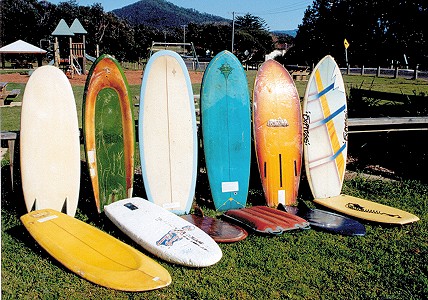
Paipo Exhibition, Shoalhaven Heads
SLSC, September 2006.
Catalogue
- in Preparation : 2. Paipos - prone boards
P1933 - 1970 Surfoplane
Manufacturer Unknown
, 2ft 7''
Moulded four ribbed
rubber mat, inflated by valve at the tail, two moulded rubber handles
on the nose.
"The Surfoplane
was invented by a Sydney doctor in 1933, Dr Ernest Smithers of Bronte NSW,
who worked for eight years to develop it. Sir Charles Kingsford Smith,
his friend was a proprietor of the invention."
- Alison
Lee, a descendent of Ernest Smithers.
The design was to be
used worldwide before supplanted by the Coolite and Canvas Mat in the 1970's.
Surfoplanes were
the first surfcraft of future World champions Mark Richards and Tom Carroll.
P1960 Plywood Belly Board
and Flippers
Reproduction : Geoff
Cater
Varnished plywood
board with redwood handle, branded text and twin fins.
Usually ridden with flippers (swim fins),
popular with juvenile riders thousands of these boards were built in school
workshops across Sydney in the early 1960s.
P1962 Twin Fin Bellyboard-
Kneeboard
Barry Bennett Surfboards, Brookvale. 5ft
1''.
Stringerless blank, Volan glassed with
cream gel coat and twin long base fins.
A new decal is laminated over the damaged original - thanks to Greg
Bennett at Bennett Surfboards.
P1967 Kneeboard
Barry Bennett Surfboards, Brookvale.
5 ft 7''
1/8 '' Stringer, foam blank, Volan fibre
glass.
The post production resin gel coat probably
covers extensive repairs to the rails and/or bottom.
Item donated by Andy Mark.
P1972 Coolite
Haminex Pty Ltd : Midget Farrelly Model,
4 ft 10"
Coolite, Adhesive decal, Rubber fin.
A hugely popular craft, it quickly replaced
the long lasting Surfoplane.
By the end of the 1970's, Coolite boards
were available for $2.00 extra with a purchase of a bucket of Kentucky
Fried Chicken.
Item donated by John McInnes.
P1972 Zippy Boards
Large 'Super Surfer' 3ft.
Small 'Hunters Toyline' 16''
Molded hollow plastic.
Mainly used as a swimming aid, but the
larger models were used by some juvenile surf-riders.
P1973 Greenough Spoon Kneeboard
Jackson Surfboards, Caringbah, 5 ft 10"
Stringerless blank, Volan glassed with
pigment laminate on bottom
Low volume flex body kneeboard, originally
designed and ridden by George Greenough in 1965.
The board was designed specifically for
hollow, powerful, long walled waves such as Rincon (California) or Lennox
Head (NSW).
Greenough's boards, fins, films and his
surf-riding performance (on Spoons and Mats) was a huge influence.
P1973 Spoon deck Kneeboard
Backyard manufactrurer, 5ft
6"
Fibreglassed foam blank, 1/4"stringer,
tint laminate.Hand drawn decal and G&S logo.
Homemade board with a strong Greenough
influence but with increased floatation and simpler construction.
P1974 Flextail Slab Kneeboard
Barry Taylor Surfboards, Nowra, 5 ft 6"
Foam blank, 1/8" redwood stringer,
Volan glass tint laminate, tail-deck patch, resin gel coat decor, Handmade
fibreglass fin box.
An example of The Slab, originally
designed by Peter Crawford in 1969 at Wallace Surfboards (the name credited
to Midget Farrelly) as an alternative to the low floatation Greenough Spoon,
the Slab has been in constant production in all fin combinations.
The short flex tail and the fin are a
direct Greenough influence, also note the hand made fibreglass Bahne design
fin box.
P1975 Belly Bogger
Belly Booger Pty. Ltd. 3ft 7''
Hollow Molded plastic with twin rounded
keel fins.
A mass production board, again with Greenough
inspired spoon deck.
This example is severely deformed.
Item courtesy of Rob Bell.
P1976 (Canvas) Mat
Merrin Investments, Pty Ltd; 5 ft
4"
Rubberized canvas, plastic and rope handles,molded
rubber twin fins.
Although ridden and promoted by George
Greenough, these were largely marketed as supplementary amusement for "surfer's
girlfriends".
P1976 Kneeboard Slab Tri-fin
Crozier Surfboards, Dee Why. 5 ft 4".
Shaped by Chris Crozier.
Foam blank with 1/4" redwood stringer.
Multi sprayed. One 14" and two 6" finboxes.
Later version of Peter Crawford's Slab
design, the board demonstrates this period's
intensive experimentation with multiple fins & detailed bottom features.
Item donated by Tony Matthews.
P1980 Morey Boogie
Morey Boogie, Mach 7. 3ft 6''. Designed
by Tom Morey.
Foam core with laminated sponge deck and
rails, and plastic 'slick' bottom.
Invented by Tom Morey in 1971, based on
the Hawaiian paipo and incorporating flex (Greenough) and ‘vacuum track
rails’ (Greenough / Brock hull design).
Originally offered as a buyer assembled/mail
order product the soft construction circumvents bodysurfing area restrictions.
Extensively copied, it is the largest
selling surfcraft design of the twentith century.
P1983 Four fin Kneeboard
Express Shapes (Surfboards), Heathcote.
5 ft 7''. Shaped by Paul Armstrong
Foam blank, 1/8'' redwood stringer, fibreglassed,
finboxes, spray decor.
Short lived multi-fin experimentation,
credited to Glen Winton from the Central coast, following the successful
introducton of Simon Anderson's Thruster, 1981.
Catalogue
- in Preparation : 3. Sailboards
Q1986 Saiboard
Farrelly Surfboards,
Brookvale. 8ft 6'' Shaped by Midget Farrelly.
Foam blank with
double stringers, extensive spray, tri finboxes.
High performance
wave sailing board shaped by Midget Farrelly.
Q1986 Saiboard
Mike Davis Surfboards,
Kiama. 8ft 6''?
Foam blank with
double stringers, extensive spray, finboxes.
Assymetric sail
board designed for riding the wave in one direction only, in this case
left.
Item donated by Andy Mark.
Catalogue
- in Preparation : 4. Images
R1778 John Webber : "A View of KaraKakooa,
in Owyhee.", Detail and Portrait of Capt. James Cook.
First drawing of a surfboard by the official
artist of Cook's third voyage to the Pacific that included the discovery
of the Hawaiian Islands.
Although it is commonly reported, Cook
did not comment on surf-riding in his journals.
There are, however, at least seven accounts
of surfboards and/or surf-riding in the journals of Cook's crew.
Lueras (1984) Pages 44 - 45, Lueras (1984) Page 47 and
Postcard :Australian Portrait Gallery?
R1819.a Jacques Arago,
Engraving
: Alphonse Pellion : "The Houses
of Kraimokou".
A wonderfully detailed ilustration of Hawaiian dwellings, with
the chief in ceremonial dress and his wife beating
tapa cloth. Like all the other early images, she is bare breasted.
The large Olo board takes a central position in the drawing and presumably
a similar culutural position.
Colourised version from the Mr. and Mrs. Severson Collection,
printed in Lueras (1984) Page 35.
R1819.b Jacques Arago : "Wahine,
Hawaii, circa 1819."
The image does not illustrate wave-riding and is decorative, rather
than informative.
Magan and Finney (1971) Page 19.
Both images originally printed in Freycinet, L : Voyage autour du
mode ... 1817 - 1820.
Chez Pillet aine, Paris. 1825,
R1830 F. Howard :
"Sandwich Island Surf-riders."
The first reported Western image of surf-riding,
it correctly identifies stance.
First published in Rev. William Ellis
: Polynesian Researches, During a Residence of Nearly Eighty
Years in the Society and Sandwich Islands,
Volumes I to IV.
Finney and Houston (1996) Frontpiece.
R1841 Francis Olmsted
: "Sandwich Islanders Playing in the Surf."
The first image by the same writer and
artist, certainly based on personal observation.
First printed in Francis Olmsted, F.A.
: Incidents of a Whaling Voyage...
Appleton and Co., NY, 1841. Page 222 or
223.
Lueras (1984) Page 39.
R1851 Anonymous, in Cheever (1851):
"Hawaiian
Sport of Surf Playing.'' ???
First magazine article with surfing text
and surfing illustration.
Image and surf-riding text was printed in Cheever, Rev. Henry
T. : "The Sandwich Islands Today"
The International Monthly Magazine of Literature, Science and Art.
Volume IV, Number III, October 1851, pages 298 - 299. Stringer and
Townsend, New York.
Finney and Houston (1996) Page 26.
R1872 Anonymous : "Surf-bathing
Failure" and "Surf-bathing Success"
The images accompanied, famous American
author, Mark Twain's account of his attempts at surfboard riding in Hawaii,
published in Roughing It (1872), page 258 reproduced.
Margan and Finney (1971) Page and Page
. Roughing It page - Lueras
R1874 Wallis McKay : ''Summer
Cruising in the South Seas" and "Surf-swimmers".
The cover and frontpiece of.Charles Warren
Stoddard's Summer Cruising in the South Seas (1874).
The first book with a surf-riding illustration
on the cover.
The frontpiece is a highly detailed illustration
indicating various riding positions, stance, duck-diving, waves in sets,
off-shore winds and significant wave height.
R1904 S. Cocks (Kiama) : ''Beautiful Illawarra"
(Postcard)
A view of Seven Mile Beach and Mt. Coolangatta
from Gerroa, the postcard is dated 31st December 1904.
R1908 Hall & Co. : ''Shooting the Breakers,
Manly" (Postcard)
Body surfing at Manly Beach, the postcard
is dated 13th February 1908, six years before Duke Kahanamoku's visit in
1914-1915..
The message appears to suggest the sender
has witnessed the activity.
R1919 A.R. Gurrey : "Riding the Surf at Honolulu".
An early photograph of surf-riding,
probably first printed in
The Mid-Pacific Magazine.
This copy accompanied an article, "The
Geography of Games" in National Geographic Magazine August,
1919 Volume XXXVI Number Two. Page 98.
R1924 Uncredited : ''Board portrait'',
''Surfing Headstand'' and R. K. Bonine : ''Riding the Surf".
Photographs from "The Hawaiian Islands"
in National Geograghic Magazine February 1924 Volume XLV
Number Two.
The board portrait is an advertisment
for the Hawaiian Tourist Bureau and the headstand photograph was extensively
reproduced as a postcard.
The colour plate is hand tinted, two riders
are wearing swimming costumes with the logo of the Outrigger Canoe Club,
the world's first formal surf-riding club, circa 1911.
1935 Tom Blake : "Waves and Thrills at Waikiki"
(Eight photograhs).
National Geograghic Magazine
May 1935 Volume 47 Number 5. Pages 597 - 604.
The quiver photograph (probably the first)
illustrates solid wood and Blake's early hollow boards and has been extensively
reproduced.
The surf-riding photographs, taken from
the water, illustrate male, female, tandem and juvenile riders.
The white caped female in the canoe is
American aviatrix, Amelia Earhart, who disappeared on her flight from Hawaii.
They were also published in Blake's seminal
surf-riding book, The Hawaiian Surfboard (1935).
R1939 Tom Blake : "Improved Hollow Surfboard for
All Round Sport"
Cover, colour illustration
(page 141) and article (pages 174 - 175) from Popular Science Magazine
June 1939 Volume 134 Number 4.
Page 176 (obscured) details surfboard
rescue technique and conversion to a sailboard.
R1967 Bob McTavish : "Bob McTavish is in this wave.
He probably had a plan to get out of it."
Surfing World Magazine January
1967 pages 15 to 21.
Bob McTavish's extensive Malibu repetoire
circa 1966 with the emphasis on "Involvement", re-defining surfing performance.
Within six months of this article,
Bob McTavish (and others) would reduce board lengths from 9ft 6'' to 7ft
6'',
rendering the Malibu board (and large
sections of this article) obsolete for the next fifteen years.
R1967- 1968 Bob McTavish : "LADIES
AND GENTLEMEN AND CHILDREN OF THE SUN.."
SURF INTERNATIONAL Magazine Vol.
1. No. 2 December1967 - January 1968 Page 9.
Ground breaking analysis of surfing performance
that rejects the accepted approach (Detailed in Bob
McTavish is in this wave. He probably
had a plan to get out of it. See above) and establishes the dictum
"BREAK OUT FROM THE STRAIGHT LINE.".
In design this is achieved by: "Elimination
of two feet of board."
R1968 Bob McTavish : "A plastic drinking straw...."
SURF INTERNATIONAL Magazine Vol.
1. No. 3 February - March 1968 Page 11.
Bob McTavish's account of the Honolua
Bay sessions, featured in Paul Witig's Hot Generation and
Eric
Blum's The Fantastic Plastic Machine.
R1971 Murphy - Falzon : "Nat and
his boards and his surfing - a pictorial."
Tracks magazine, October 1971,
Pages 14 and 15.
Photographs by Gareth Murphy and Albert
Falzon, some from Falzon's The Morning of the Earth.
The boards are early examples of Nat Young's
Pintail and Backhand (Square tail) designs.
R1973 Bob McTavish :
"Pods for Primates - a personal history of surfboard design - Part 1."
Tracks Magazine March 1973
Reprinted circa 1973 in The Best of
Tracks.
Images include Duke Kahanamoku, Waikiki
Surfer, Phil Edwards and Joey Cabell.
R1973 Bob McTavish : "Pods for Primates - a personal
history of surfboard design - Part 2."
Tracks Magazine April? 1973
Reprinted circa 1973 in The Best of
Tracks.
Images include Miget Farrelly, George Greenough, Nat Young and Bob
McTavish.
R1974-1977 "Ben Apia Stinger Plans" (right) and
"Mark Richards' Stinger Quiver" (1977).
Plans by Rick Neilson : "Ben Apia's Tiny Bubbles"
Tracks Magazine November 1974 # 50, page 45.
Mark Richards' quiver, circa 1977 includes Stingers by Ben Apia and
Dick Brewer and his newly shaped Brewer Twin Fin.
Surfing World magazine, Volume 25 Number 3 July 1977 Page ?
Photograph by Hugh McLeod?
R1977 Mark Richards : "The New Look Twin Fin".
Mark Richards' newly shaped Brewer Twin Fin.
Surfing World magazine, Volume 26 Number 1, December 1977? Pages
52-53. Photograph by Hugh McLeod.
R1977 "Bob McTavish Joins Sky " (Advertisment)
Tracks Magazine, 1977, Page 4.
Demonstrates McTavish's experimentation with a a full range of craft
- North Coast speed pins, Guns, Twin Fins, Malibus, Mini Malibus and Kneelboards.
R1978 Bob McTavish : "The Ace in the Hole - The
Asymmetric Story".
Seanotes Magazine August/September 1978. Pages 38 - 39.
An obscure surfboard design development, the asymmetic template had
a strong following in sailboard design circa 1983 - 1988.
R1978 "Bronzed Aussies Surfboards" (Advertisement)
Featuring Ian Cairns, Peter Townend and Cheyene Horan.
Surfing Magazine August 1978. Volume 14. Number 4. Page 9.
R1979 "Windsurfer - The Ultimate Fre Ride" (Advertisement)
Surfer Magazine, February 1979. Volume 20. Number 2. Page3.
A very early photograph of a wave sailing Windsurfer - note the original
teak boom.
Windsurfer decals from both US and European patent holders and Windsurfer
board template.
The Windsurfer was designed by Californian surfers, Jim Drake
and Hoyle Scheweitzer, circa 1969.
The board was adapted from the standard Malibu design and the elemental
design features were the multi-directional universal and the double sided
boom.
Sailboard riding and design would subsequently have a significant influence
of surfboard design (epoxy construction) and performance (tow-in surfing).
The off-set mount is due to a magazine printing error.
R1989 Geoff Cater : "Paul
Flack & Bryne Sailboard, Shoalhaven Heads."
R1992 John McInnes :''... flat and uninteresting beachbreaks..."
The title is taken from Nat Young's
Surfing Australia’s East Coast (1980), Chapter 8.

surfresearch.com.au


